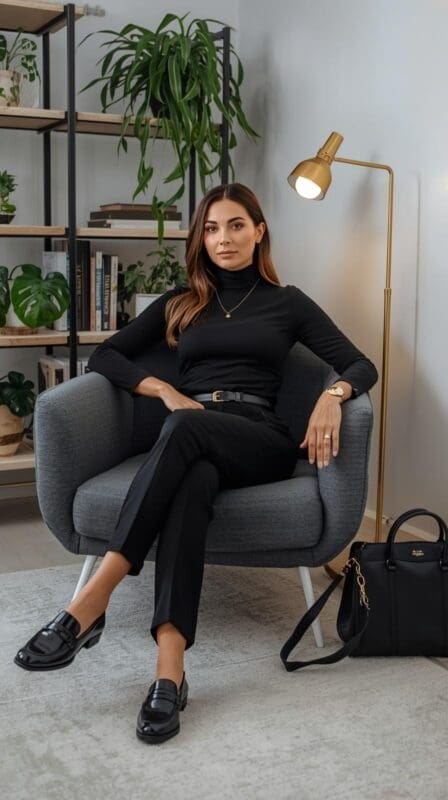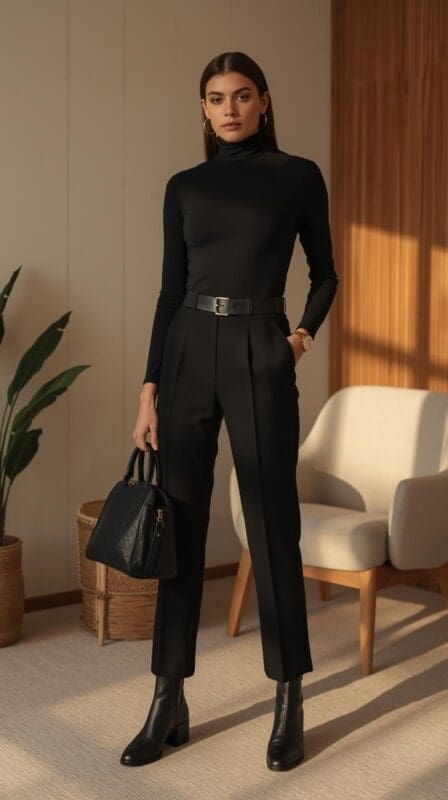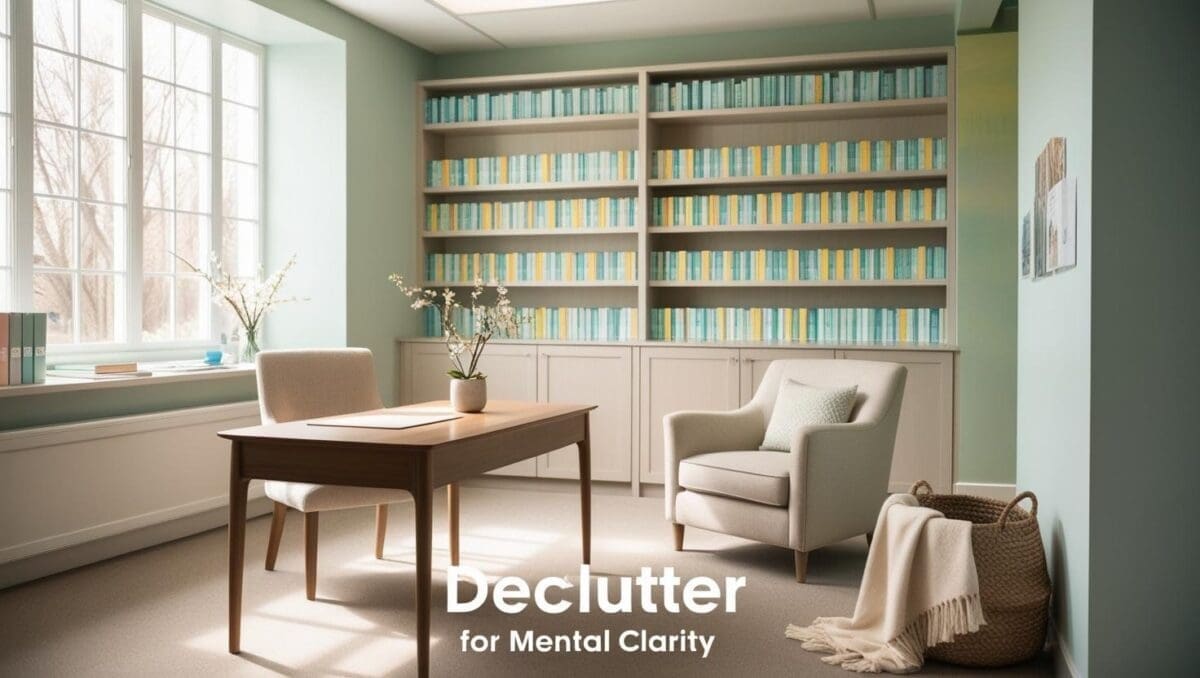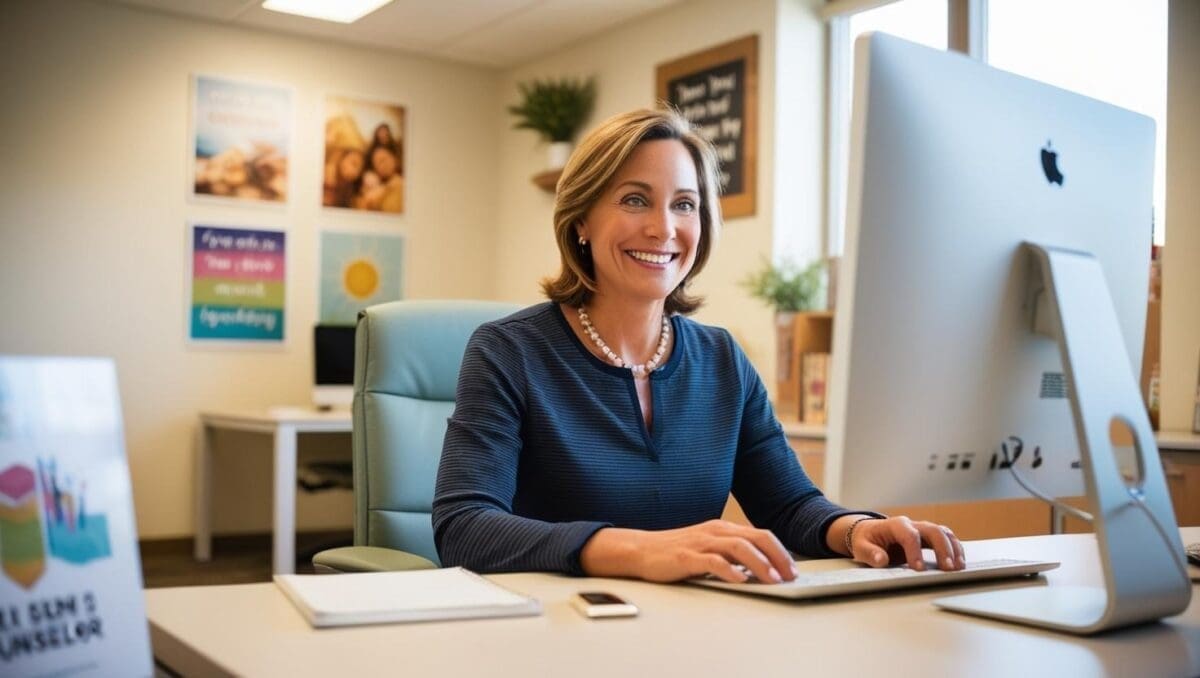Why All-Black Works for Therapy Professionals
There’s a reason all-black outfits never go out of style. They’re sleek, timeless, and professional — but for therapists and counselors, black also has subtle emotional power.
In therapeutic spaces, your presence is your tool. What you wear communicates calm, containment, and approachability. An all-black wardrobe creates that sense of grounded simplicity — reducing visual noise so clients can relax and focus.
Black isn’t just a color choice. It’s a mindfulness practice, a boundary cue, and a confidence anchor rolled into one.
The Hidden Psychology of Wearing Black
In color psychology, black symbolizes containment, authority, and focus — qualities that align perfectly with therapeutic presence. Research in professional perception studies suggests that people wearing darker, monochrome colors are seen as more trustworthy and competent.
In therapy, that matters.
- Grounding energy: Black conveys stability. Clients subconsciously register it as calm and steady — essential during emotional sessions.
- Professional neutrality: Neutral clothing allows clients to project their thoughts without distraction from bold patterns or bright tones.
- Boundary clarity: Dressing intentionally signals readiness to “step into role,” helping therapists separate personal identity from clinical presence.
- Confidence and containment: For the wearer, black feels like armor — supportive but not harsh, structured yet comfortable.
🖤 Counselor insight: “Wearing black feels like holding space visually — nothing loud, just quiet strength.”
1. The Classic Turtleneck & Trousers
Slim black turtleneck tucked into tailored trousers with loafers or ankle boots.
Why it works: Streamlined, cozy, and universally flattering. The soft neckline feels protective, ideal for long sessions in cooler offices.
2. Black Sweater Dress with Tights
Ribbed black sweater dress belted at the waist; add opaque tights and suede boots.
Why it works: Effortless, feminine, and movement-friendly. Textures like knit and suede add warmth without visual clutter.
3. All-Black Blazer Look
Tailored blazer over a silk or jersey blouse with slim trousers.
Why it works: A quiet-luxury look for supervision or presentations. Polished without feeling corporate.
💬 Therapist note: Clients often mirror our tone — structured outfits can subtly encourage focus.
4. Wide-Leg Trousers & Knit Top
Wide-leg wool trousers + fitted knit top + loafers.
Why it works: The perfect blend of authority and comfort for long seated hours.
5. Black Midi Dress with Cardigan
Sleeveless black midi dress layered under a knit coatigan.
Why it works: Transitional for fall and winter offices; looks elegant yet grounded.
🧶 Texture tip: Soft knits convey safety and warmth in child-therapy settings.
6. Leather Accents Monochrome
All-black base (turtleneck + trousers) with slim leather belt, satchel, or boots.
Why it works: Adds quiet luxury and structure while maintaining simplicity.
7. The Jumpsuit Look
Structured black jumpsuit with a wool coat and ankle boots.
Why it works: No-decision outfit for busy mornings. Clean lines, full coverage, effortless polish.
8. Black Pencil Skirt Outfit
Pair a black pencil skirt with fitted knit top and opaque tights. Add ankle boots or classic flats.
Why it works in therapy: Professional silhouette without overcomplication.
9. All-Black Layered Textures
Silk blouse + wool trousers + suede flats + knit cardigan.
Why it works: Texture variation keeps monochrome visually interesting while remaining soothing for clients.
10. Casual Friday All-Black
Black jeans + oversized knit + loafers or sneakers.
Why it works: Balanced comfort and cohesion — perfect for schools or community centers.
11. Minimalist All-Black Dress
Long-sleeved, unbelted black dress in soft jersey.
Why it works: Projects serenity and confidence. No distractions, just flow.
12. Statement Coat Layer
Black base (turtleneck + trousers + boots) under a wool wrap coat.
Why it works: A polished commute-to-session look; maintains professionalism even outdoors.
Quiet Luxury Styling for Therapists
“Quiet luxury” isn’t about price — it’s about intentional simplicity. It means fewer, better pieces that communicate presence through quality.
How to achieve it:
- Choose natural fabrics (wool, cotton, silk blends).
- Focus on fit — tailoring transforms affordable basics.
- Keep accessories minimal: a small pendant, leather tote, soft scarf.
- Stick to textures that photograph well for online sessions (matte over shiny).
The Emotional Impact of Color in Therapy
Color psychology research links black with containment, control, and clarity — the same qualities that define therapeutic boundaries.
But monochrome dressing can also regulate your own mood:
- Calm focus: Wearing one color reduces cognitive load (decision fatigue).
- Professional confidence: Uniform dressing builds consistency and self-trust.
- Neutral energy: Clients project less onto a neutral canvas, making space for their own stories.
🧠 Therapist insight: “I notice clients settle faster when my outfit doesn’t draw attention. They say the space feels quieter.”
How to Build Your All-Black Capsule Wardrobe
1. Start with Core Layers
- Two black trousers (one structured, one relaxed)
- One midi dress
- One turtleneck, one silk blouse, one crewneck sweater
2. Add Seasonal Texture
- Wool blazer, knit coatigan, or trench coat
- Leather loafers and ankle boots
3. Finish with Mindful Accessories
- Soft scarf, minimalist jewelry, crossbody tote
Therapist Wardrobe Mindset: Dressing as Grounding Practice
Getting dressed can become a small act of centering before holding space.
Try this mindful ritual:
- Choose your outfit the night before to reduce decision fatigue.
- While dressing, take one grounding breath and set an intention:
“May I bring calm and presence into each session today.”
Clothing becomes less about performance and more about presence.
When All-Black Isn’t Enough: Adding Mindful Accents
If full monochrome ever feels too heavy, introduce subtle grounding tones that keep the same energy:
- Charcoal or graphite gray → stability and softness.
- Camel or taupe accessories → warmth without distraction.
- Muted metals (brass, rose gold) → gentle highlights for jewelry.
Mental-Health Benefits of Simplifying Your Wardrobe
Minimal wardrobes are proven to lower stress. Decision fatigue is real — and therapists already make hundreds of micro-decisions daily.
- Less clutter = fewer stress cues.
- Consistent palette = faster mornings.
- Neutral tones = visual calm for both you and your clients.
🧘 Try this: Limit your daily palette to black, white, and beige for one month. Notice how much mental energy you save.
For Male Therapists: Sleek Simplicity
Black works equally well across genders. Try:
- Black chinos + knit polo
- Black blazer + tee for modern smart-casual
- Textured wool sweater + dress shoes
Tip: Use fit and fabric to convey professionalism — slim but not tight, matte over shiny.
Quiet Authority: The Message Your Outfit Sends
When you walk into a session in a calm, cohesive outfit, you communicate:
“This is a safe space. I’m grounded, and you can be too.”
All-black dressing supports that message. It’s non-intrusive yet confident — a steady backdrop for empathy.
🪞 Reflective prompt:
How does your clothing affect your sense of authority, warmth, and balance?
Final Thoughts: Minimalism as Professional Mindfulness
All-black outfits aren’t about gloom — they’re about clarity and calm. They offer simplicity in a world that’s loud, grounding in a profession that’s emotional, and elegance that never distracts.
For psychologists, counselors, and mental-health professionals, what we wear is part of our therapeutic presence.
Black reminds both us and our clients that stability can be quiet, and confidence can be soft.
🖤 “Wear black not to disappear, but to hold space with grace.”
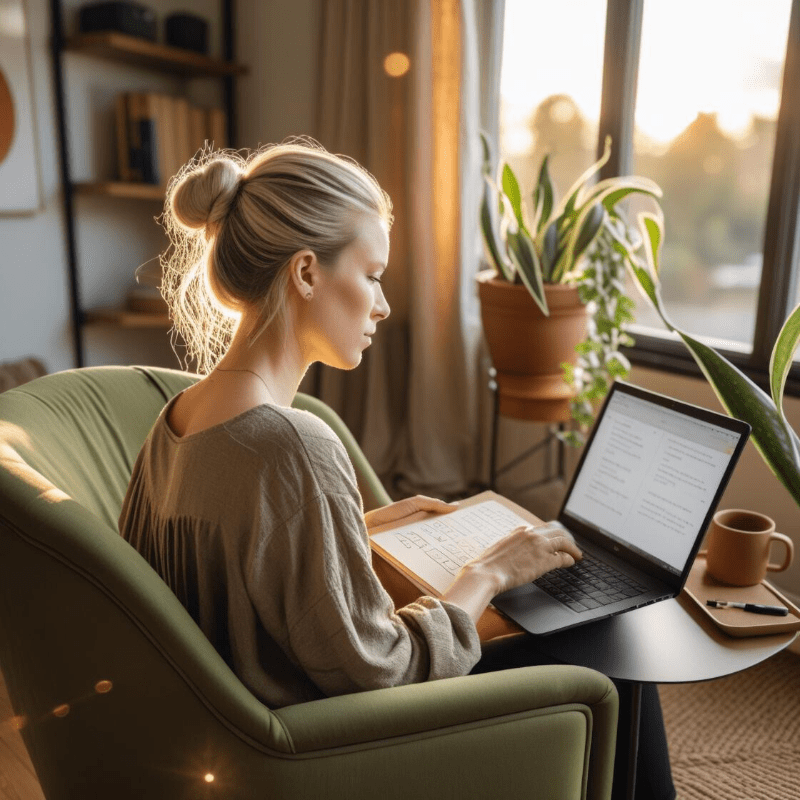
About the Author
Hi, I’m Eve, a former school counselor with a master’s degree in School Psychology and a passionate advocate for children and families navigating sensory challenges. As a mom of children with sensory sensitivities, I deeply understand the journey special-needs parents face, and I dedicate myself to researching and sharing practical solutions to help children thrive and feel comfortable in their bodies. My goal is also to empower counselors, therapists, and psychologists with creative strategies and supportive resources to enrich their everyday practice. When I’m not writing or exploring new therapeutic approaches, you’ll find me spending quality time with my family and continually seeking inspiration from everyday moments.


